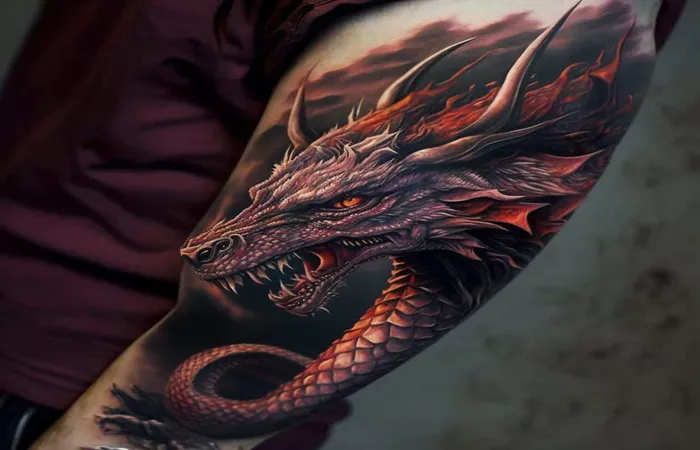Tattoos have been a popular form of self-expression for centuries, and the dragon tattoo is one of the most iconic designs. Dragons have been used as symbols in many cultures throughout history, representing different meanings and attributes depending on the culture. When getting a dragon tattoo, one of the most important decisions to make is whether the dragon should face up or down. This decision can affect the overall look and meaning of the tattoo, and should be carefully considered. In this article, we will explore the different factors to consider when deciding whether a dragon tattoo should face up or down, and provide some guidance on how to make this decision.
The Meaning of the Dragon Tattoo:
The meaning of a dragon tattoo can vary depending on the culture it comes from. In Chinese culture, the dragon is seen as a symbol of good fortune, protection, and prosperity. In Japanese culture, the dragon is often seen as a symbol of strength and power. In Celtic culture, the dragon is often seen as a symbol of wisdom and knowledge.
The orientation of the dragon can affect the meaning of the tattoo. If the dragon is facing up, it can represent protection and guidance, as the dragon is often seen as a symbol of wisdom and knowledge. If the dragon is facing down, it can represent personal strength and power, as the dragon is often seen as a symbol of masculinity and courage.
It is important to consider the individual’s personal beliefs and cultural background when deciding on the meaning of the tattoo. For example, someone with a Chinese background may choose to have a dragon facing up to represent good fortune and protection, while someone with a Celtic background may choose to have a dragon facing down to represent personal strength and power.
The Placement of the Tattoo:
The placement of the tattoo can also affect the orientation of the dragon. If the tattoo is on the back, the dragon can face up or down, depending on the individual’s preferences. If the tattoo is on the arm or leg, the dragon may need to face a certain direction in order to fit the natural contours of the body.
When deciding on the placement of the tattoo, it is important to consider the overall design of the tattoo. If the dragon is part of a larger design, the orientation of the dragon may need to be adjusted in order to fit the overall composition of the tattoo. The placement of the tattoo can also affect the visibility of the tattoo, as well as the ability to conceal it if necessary.
The Style of the Tattoo:
The style of the tattoo can also affect the orientation of the dragon. If the tattoo is in a traditional Japanese style, the dragon may need to face a certain direction in order to fit the traditional design elements of the style. If the tattoo is in a more modern style, the orientation of the dragon may be more open to interpretation.
When deciding on the style of the tattoo, it is important to consider the individual’s personal preferences and cultural background. A dragon tattoo can be designed in many different styles, including traditional Japanese, Chinese, or Celtic styles, as well as more modern styles. The style of the tattoo can also affect the overall look and feel of the tattoo, as well as the level of detail and color used.
When getting a dragon tattoo, it is important to work with an experienced tattoo artist who can help guide the individual through the decision-making process. The tattoo artist should have a strong understanding of the symbolism and meaning of the dragon, as well as the different styles and placement options available.
The tattoo artist should also be able to work with the individual to create a personalized and meaningful design that reflects their personal story and journey. The tattoo artist should use sterile equipment and follow proper aftercare instructions to ensure that the tattoo heals properly and looks great for years to come.
Aftercare and Maintenance of the Tattoo:
After getting a dragon tattoo, it is important to take proper care of the tattoo to ensure that it heals properly and looks great for years to come. The tattoo artist should provide aftercare instructions, which may include keeping the tattoo clean and dry, avoiding direct sunlight, and avoiding activities that may cause the tattoo to rub or irritate.
It is also important to maintain the tattoo over time, as tattoos can fade or blur over time. This may include getting touch-ups or re-inking the tattoo, as well as using sunscreen to protect the tattoo from fading in the sun.
Conclusion:
In conclusion, a dragon tattoo can be a powerful symbol that represents different meanings and attributes depending on the culture it comes from. When deciding whether a dragon tattoo should face up or down, it is important to consider the individual’s personal beliefs and cultural background, as well as the meaning and symbolism of the dragon. The placement and style of the tattoo can also affect the orientation of the dragon and should be chosen with care. Working with an experienced tattoo artist can help ensure that the tattoo is both meaningful and visually striking, and taking proper care of the tattoo can ensure that it looks great for years to come. A dragon tattoo can be a meaningful and powerful addition to one’s personal story and journey, and should be chosen with care and consideration.
Related topics:

